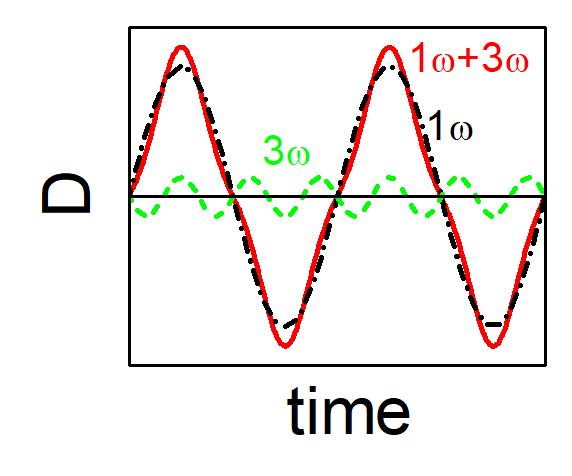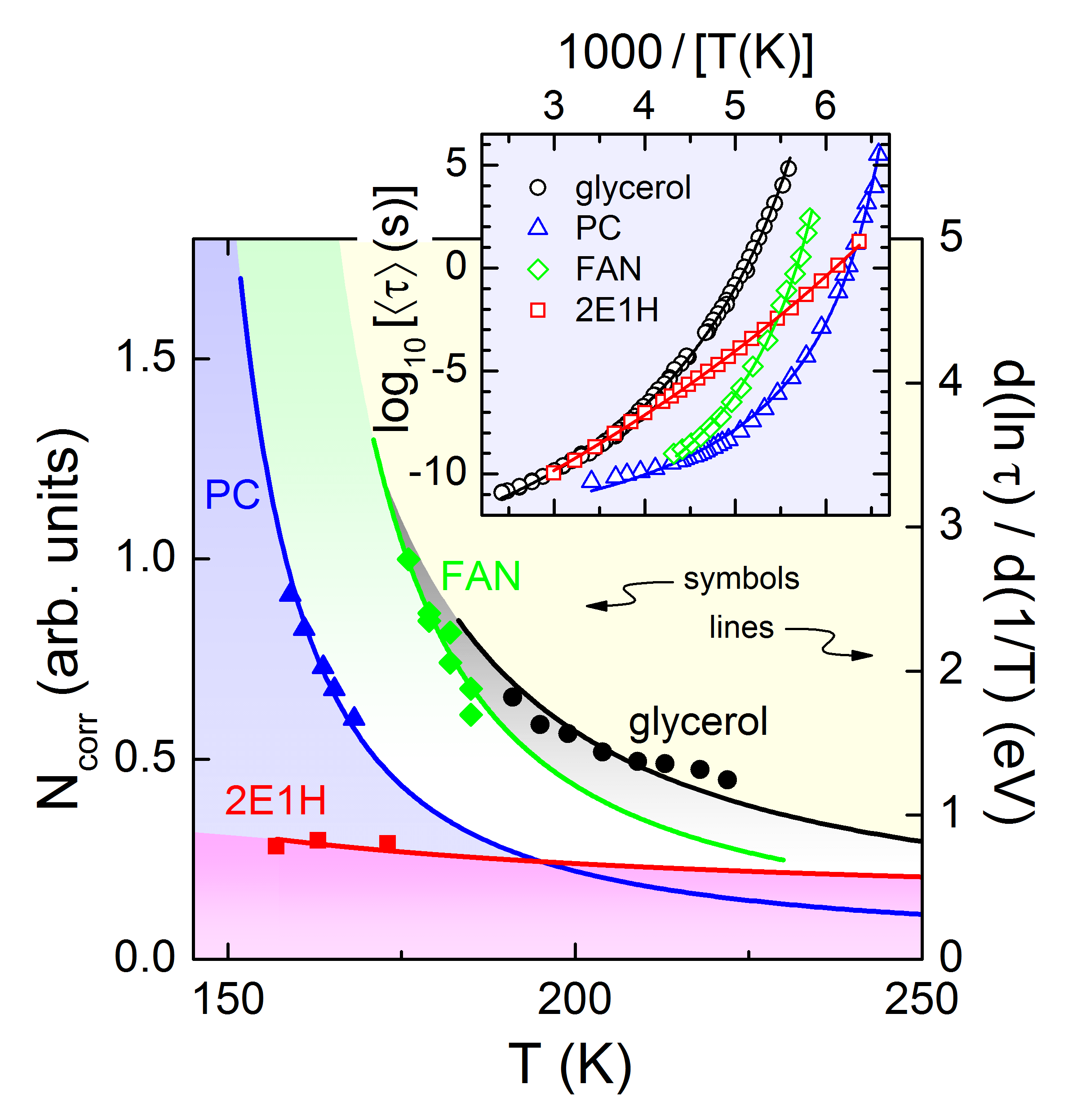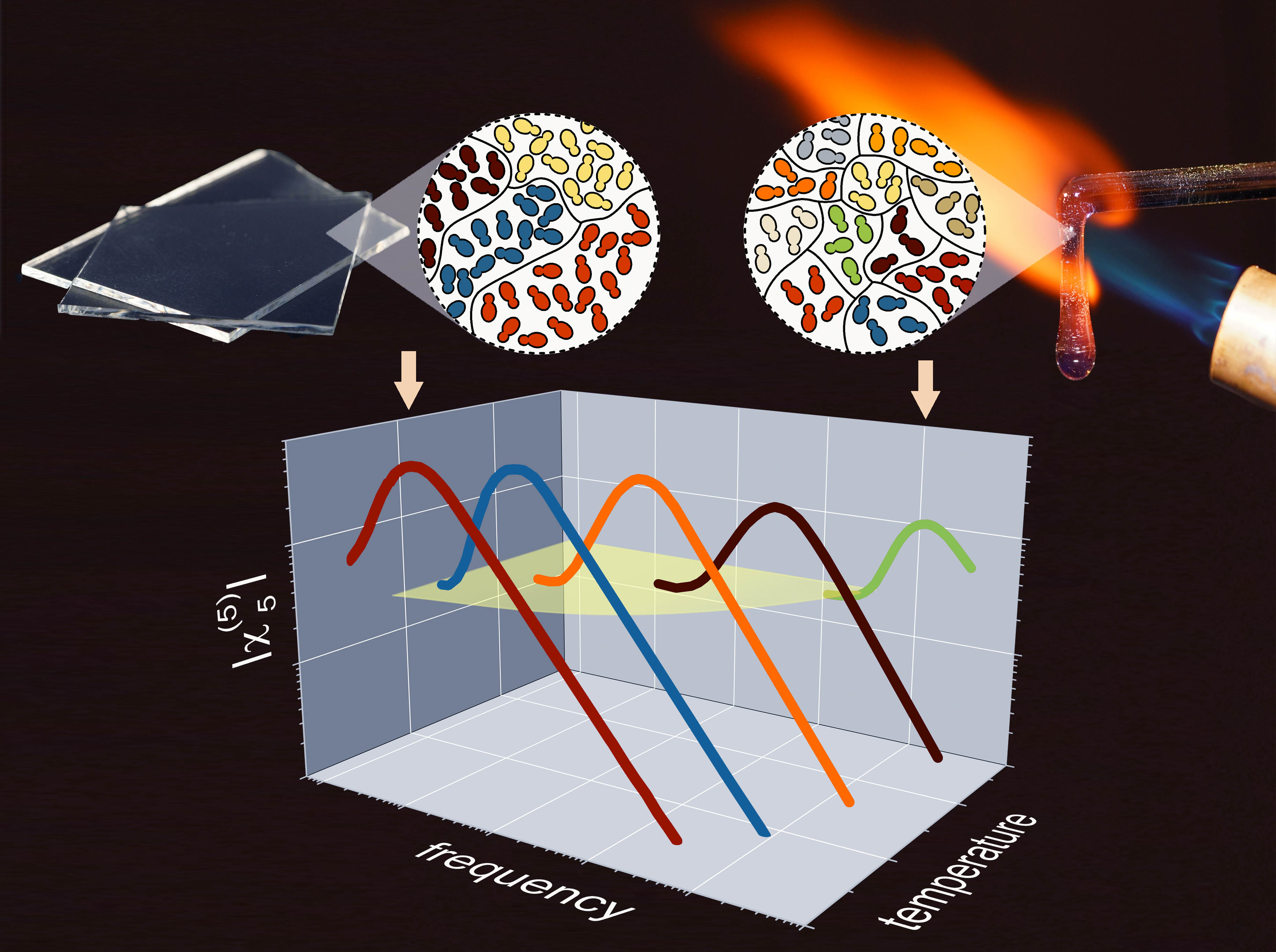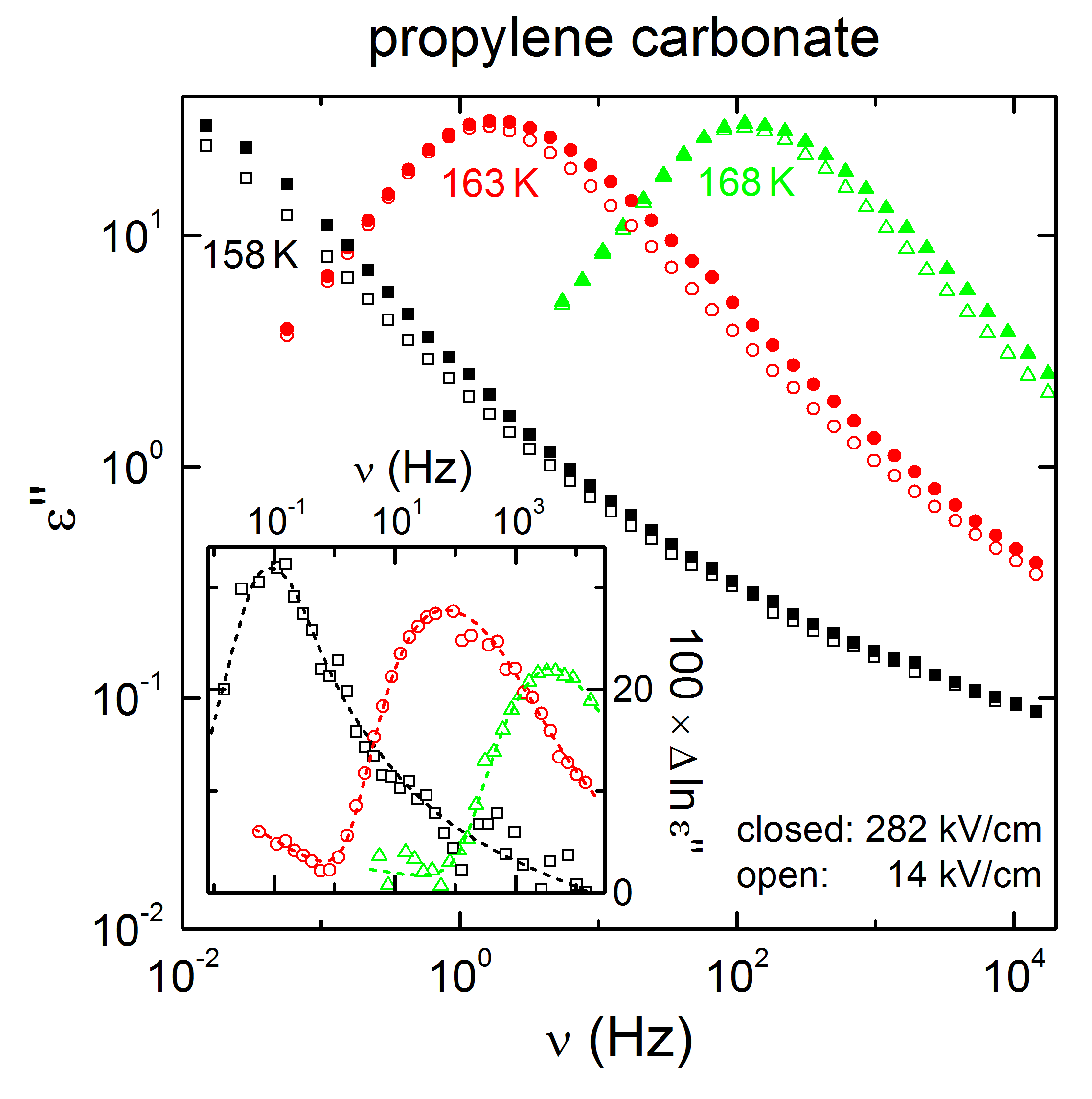
|

|
[from: P. Lunkenheimer, M. Michl, Th. Bauer, and A. Loidl,
Investigation of nonlinear effects in glassy matter using dielectric methods,
Eur. Phys. J. Special Topics 226, 3157 (2017).] |
In recent years, the nonlinear properties of glass formers have attracted increasing attention. Especially, from nonlinear dielectric experiments valuable information on the microscopic mechanisms governing the different dynamic processes of the molecules in glass-forming materials and on the glass transition in general can be obtained.

|

|
[from: P. Lunkenheimer, M. Michl, Th. Bauer, and A. Loidl,
Investigation of nonlinear effects in glassy matter using dielectric methods,
Eur. Phys. J. Special Topics 226, 3157 (2017).] |
In conventional dielectric spectroscopy, the linear response of a glass former to an applied external field is detected. Such experiments are intended to check the dynamics that would be present even without the field. Thus, the applied voltage is rather low (usually U ~ 1 V). In marked contrast, in nonlinear experiments very high voltages up to the kV range are applied, thus driving the investigated material into a nonlinear regime. This nonlinear dielectric response is monitored, e.g., by determining the dielectric permittivity at high fields. Alternatively, the higher harmonics of the dielectric response can be detected: At low field, polarization P and field E are proportional to each other (see left Figure above). Therefore, applying a sinus ac field leads to a sinusoidal polarization P(t) with the same frequency. However, at high fields, P ∝ E no longer is valid and an applied sinus with frequency ω can result in higher harmonics with frequency 3ω, 5ω etc., similar to the overtones of many musical instruments (see right Figure above). Their contributions are characterized by the higher-order susceptibilities χ3, χ5 etc.
An overview on the nonlinear dielectric behaviour of glass-forming matter is provided in:
|
Investigation of nonlinear effects in glassy matter using dielectric methods P. Lunkenheimer, M. Michl, Th. Bauer, and A. Loidl Eur. Phys. J. Special Topics 226, 3157 (2017). [arXiv:1704.07348] |
The following work summarizes our nonlinear dielectric investigations of plastic crystals:
|
Nonlinear dielectric response of plastic crystals P. Lunkenheimer, M. Michl, and A. Loidl in Nonlinear Dielectric Spectroscopy, edited by R. Richert (Springer, Cham, 2018), p. 277. [PDF (final manuscript)] |
2. Examples:
a) Cooperativity and the freezing of molecular motion at the glass transition
Since centuries, glass blowers make use of the gradual increase of viscosity when a liquid transforms into a glass upon cooling. However, in all classes of glass-forming matter the corresponding slowing down of the motion of the structural units (atoms, molecules, ions etc.), quantified by the so-called relaxation time, proceeds significantly stronger than predicted by the naively expected Arrhenius law. Increasingly correlated motions of molecules are sometimes invoked to explain this drastic slowing down of molecular motion when approaching the glass transition. However, until now the relevance of this so-called cooperativity for glassy freezing is controversially debated. Notably, an increase of cooperativity when approaching the transition may point to a thermodynamic phase transition underlying the glass transition.

|
Third-order harmonic component of the dielectric susceptibility of glycerol.
Spectra are shown for various temperatures, measured at a field of 565 kV/cm.
The inset shows the number of correlated molecules Ncorr(T) as
determined from the measured nonlinear susceptibility.
[from: Th. Bauer, P. Lunkenheimer, and A. Loidl, Cooperativity and the freezing of molecular motion at the glass transition, Phys. Rev. Lett. 111, 225702 (2013).] |
In order to help solving this long-standing problem, we have collected detailed spectra of the third-order dielectric susceptibility of different glass-forming liquids [2,7,8,10] (see figure above for an example) and of plastic crystals [4,6,7,9]. To measure this rarely investigated quantity, extremely high voltages of up to 2000 V have to be applied to very thin samples, an experimentally challenging task. The third-order susceptibility was shown to provide direct experimental access to the number of cooperatively moving molecules in glass-forming materials [J.-P. Bouchaud and G. Biroli, Phys. Rev. Lett. 72, 064204 (2005)].
For all investigated materials, we found a surprisingly simple relation of this number and of the energy barriers impeding molecular motion [2,4,6,7,9]. The latter can be determined from the temperature-dependent relaxation times deduced by conventional dielectric spectroscopy (see figure below). We find that the increase of these energy barriers upon cooling is directly proportional to the increasing number of correlated molecules, which causes the non-canonical slowing down of molecular motion. This finally explains the unconventional glassy freezing of molecular motion, which universally occurs in such different materials as conventional silicate glasses, polymers, alcohols, ionic liquids, metallic glasses or even various kinds of biomaterials.

|
Correlation of activation energy with number of correlated molecules. The lines show
the temperature-dependent activation energies (right scale), determined from the
temperature-dependent relaxation times shown in the inset. The symbols represent the
number of correlated molecules Ncorr, determined from the measured nonlinear
susceptibilities (left scale). The Ncorr data points were multiplied by
separate factors for each material, leading to a good match with the enthalpy curves.
This provides strong evidence that the increase of Ncorr is responsible for
the increase of the activation enregies at low temperatures.
[from: Th. Bauer, P. Lunkenheimer, and A. Loidl, Cooperativity and the freezing of molecular motion at the glass transition, Phys. Rev. Lett. 111, 225702 (2013).] |
For further details, see:
|
Cooperativity and the freezing of molecular motion at the glass transition Th. Bauer, P. Lunkenheimer, and A. Loidl Phys. Rev. Lett. 111, 225702 (2013). [PDF] |
This work was also selected for a "Viewpoint" in Physics, see:
|
Clearing up the mysteries of glassy dynamics G. Biroli and J.-P. Bouchaud Physics 6, 128 (2013). |
b) Fifth-order susceptibility unveils the nature of the glass transition
The true nature of the transition from the low-viscosity liquid to the solid glass is one of the most controversial problems in the physics of condensed matter. The various theoretical approaches to this problem can be roughly divided into two classes: Those assuming that the glass transition is of purely dynamic nature, i.e, a glass is merely a hyperviscous liquid, or those assuming a thermodynamic phase transition underlying this special liquid-solid transition, which should lead to a special kind of "amorphous order". A typical phenomenon for phase transitions is the increase of cooperativity in the motion of the molecules when approaching the transition. The material is assumed to consist of regions, in which the molecules move in a cooperative way and whose sizes increase when approaching the transition. This is schematically indicated in the upper part of the figure below, where the liquid melt is shown at the right and the solid glass at the left.

|
The glass transition on a molecular level: The temperature dependence of the
5th-order harmonic component of the dielectric susceptibility reveals a growth
of cooperatively rearranging regions at the transition from the liquid to the
solid glass: Large values of the χ5 peak at low temperatures implies large
regions of cooperatively rearranging molecules, indicated in the upper part of
the figure by molecules of same color.
|
As mentioned above, measurements of higher-order susceptibilities can provide information on the temperature-dependent variation of the number of cooperatively moving molecules in glass-forming materials. Our results on the third-order susceptibility χ3 are discussed above. A further breakthrough was achieved by the measurement of the 5th-order susceptibility χ5 (see figure below for an example), which is the outcome of a very fruitful collaboration of our group with the groups of F. Ladieu, G. Biroli, and J.-P. Bouchaud (Paris, France). As shown in a joint publication by our groups published in Science [5], theoretical considerations within the "amorphous-order" scenario predict that χ5 should increase much faster than χ3 as the liquid becomes more viscous. This is indeed nicely confirmed by the performed χ5 measurements. Moreover, a comparison of the results on χ3 and χ5 reveals that the cooperative regions are compact and do not have a fractal geometry. This points toward a nonstandard nature of the phase transition underlying the glass transition.

|
Fifth-order harmonic component of the dielectric susceptibility of glass-forming
propylene carbonate. Spectra are shown for various temperatures, measured at a
field of 380 kV/cm.
[from: S. Albert, Th. Bauer, M. Michl, G. Biroli, J.-P. Bouchaud, A. Loidl, P. Lunkenheimer, R. Tourbot, C. Wiertel-Gasquet, and F. Ladieu, Fifth-order susceptibility unveils growth of thermodynamic amorphous order in glass-formers, Science 352, 1308 (2016).] |
For further details, see:
|
Fifth-order susceptibility unveils growth of thermodynamic amorphous order in glass-formers S. Albert, Th. Bauer, M. Michl, G. Biroli, J.-P. Bouchaud, A. Loidl, P. Lunkenheimer, R. Tourbot, C. Wiertel-Gasquet, and F. Ladieu Science 352, 1308 (2016). [arXiv:1606.04079] |
|
Third and fifth harmonic responses in viscous liquids S. Albert, M. Michl, P. Lunkenheimer, A. Loidl, P.M. Déjardin, and F. Ladieu J. Stat. Mech. 2019, 124003 (2019). [PDF] |
c) Nonlinear dielectric response at the excess wing of glass-forming liquids
Due to experimental limitations, nonlinear dielectric spectroscopy has been mostly restricted to rather low frequencies and limited electrical fields, only revealing information on the so-called α-relaxation, which governs, e.g., viscous flow. However, no meaningful information could be obtained on the faster dynamic processes in glass forming matter, which have come into the focus of glass physics during recent years. One of them is the so-called excess-wing process, detected in dielectric spectra at frequencies somewhat higher than those of the structural α-relaxation. Its origin is controversially discussed and its understanding seems to be prerequisite to achieve a better understanding of the molecular dynamics at the glass transition.

|
Frequency dependence of the dielectric loss of propylene carbonate, measured at low (open symbols)
and high electrical field (closed symbols), shown for three temperatures. In the inset, the difference
of the logarithm of the loss spectra shown in the main frame is plotted. The excess wing shows up as a
second, shallower decrease at the right flank of the peak (e.g., at frequencies larger than 10 Hz for
the 158K curve). In this region, surprisingly the low and high-field curves agree. This implies that,
in contrast to the main peak, there is no measurable nonlinear dielectric behaviour in the excess-wing region.
[from: Th. Bauer, P. Lunkenheimer, S. Kastner, and A. Loidl, Nonlinear dielectric response at the excess wing of glass-forming liquids, Phys. Rev. Lett. 110, 107603 (2013).] |
We have performed measurements of the nonlinear dielectric properties of prototypical glass-forming liquids up to relatively high frequencies, obtaining valuable information on the excess wing [1]. Surprisingly, we find a complete absence of any nonlinear effects in this spectral region (see, e.g., above figure). This finding seems to support long-standing assumptions of the absence of cooperativity in the molecular motions leading to the excess wing.
These results provide valuable information that helps understanding a prominent dynamic process, ubiquitous in all kinds of glasslike matter (including, e.g., ionic conductors, plastic crystals, and metallic glasses). It also demonstrates that nonlinearity in a single material can differ considerably, depending on the investigated spectral region, making further investigations of the nonlinear response in extended frequency ranges highly desirable.
For further details, see:
|
Nonlinear dielectric response at the excess wing of glass-forming liquids Th. Bauer, P. Lunkenheimer, S. Kastner, and A. Loidl Phys. Rev. Lett. 110, 107603 (2013). [PDF] |
3. Some relevant publications from our group:
| [1] | Nonlinear dielectric response at the excess wing of glass-forming liquids Th. Bauer, P. Lunkenheimer, S. Kastner, and A. Loidl, Phys. Rev. Lett. 110, 107603 (2013). [PDF] |
| [2] | Cooperativity and the freezing of molecular motion at the glass transition Th. Bauer, P. Lunkenheimer, and A. Loidl, Phys. Rev. Lett. 111, 225702 (2013). [PDF] |
| [3] | Nonlinear dielectric response of Debye, α and β relaxation in 1-propanol Th. Bauer, M. Michl, P. Lunkenheimer, and A. Loidl, J. Non-Cryst. Solids 407, 66 (2015). [arXiv:1404.3972] |
| [4] | Cooperativity and heterogeneity in plastic crystals studied by nonlinear dielectric
spectroscopy M. Michl, Th. Bauer, P. Lunkenheimer, and A. Loidl, Phys. Rev. Lett. 114, 067601 (2015). [PDF] |
| [5] | Fifth-order susceptibility unveils growth of thermodynamic amorphous order in glass-formers S. Albert, Th. Bauer, M. Michl, G. Biroli, J.-P. Bouchaud, A. Loidl, P. Lunkenheimer, R. Tourbot, C. Wiertel-Gasquet, and F. Ladieu, Science 352, 1308 (2016). [arXiv:1606.04079] |
| [6] | Nonlinear dielectric spectroscopy in a fragile plastic crystal M. Michl, Th. Bauer, P. Lunkenheimer, and A. Loidl, J. Chem. Phys. 114, 114506 (2016). [PDF] |
| [7] | Investigation of nonlinear effects in glassy matter using dielectric methods P. Lunkenheimer, M. Michl, Th. Bauer, and A. Loidl, Eur. Phys. J. Special Topics 226, 3157 (2017). [arXiv:1704.07348] |
| [8] | Unifying different interpretations of the nonlinear response in glass-forming liquids P. Gadige, S. Albert, M. Michl, Th. Bauer, P. Lunkenheimer, A. Loidl, R. Tourbot, C. Wiertel-Gasquet, G. Biroli, J.-P. Bouchaud, and F. Ladieu, Phys. Rev. E 96, 032611 (2017). [PDF] |
| [9] | Nonlinear dielectric response of plastic crystals P. Lunkenheimer, M. Michl, and A. Loidl, in Nonlinear Dielectric Spectroscopy, edited by R. Richert (Springer, Cham, 2018), p. 277. [PDF (final manuscript)] |
| [10] | Third and fifth harmonic responses in viscous liquids S. Albert, M. Michl, P. Lunkenheimer, A. Loidl, P.M. Déjardin, and F. Ladieu, J. Stat. Mech. 2019, 124003 (2019). [PDF] |